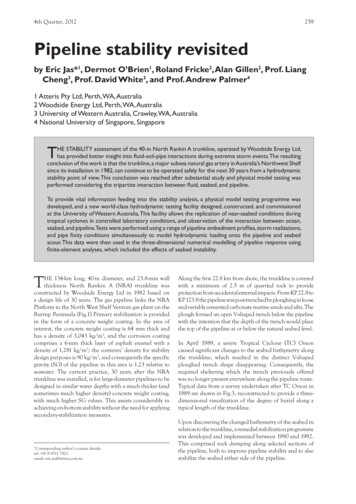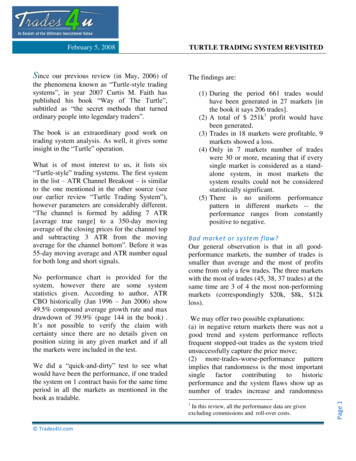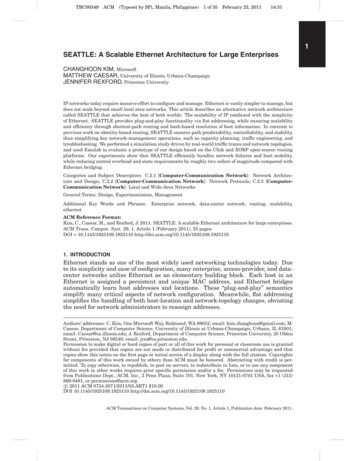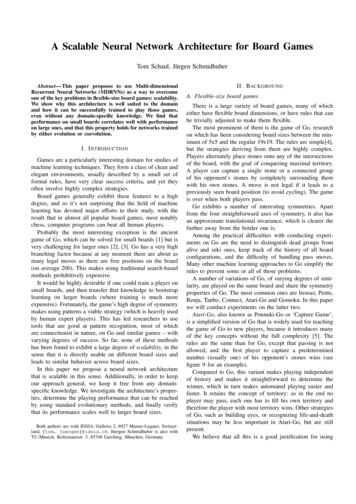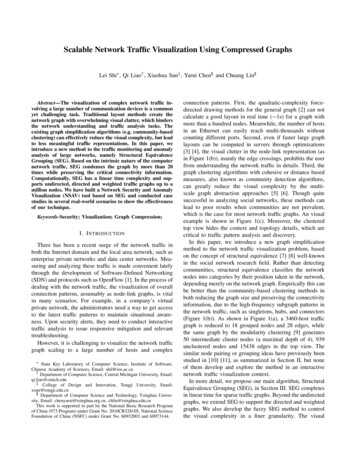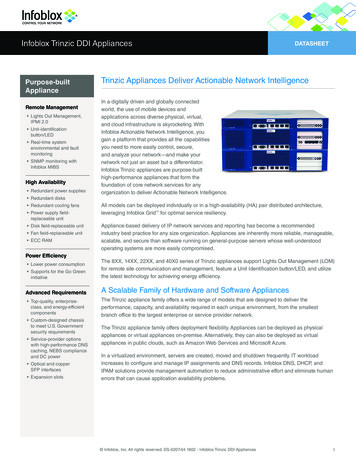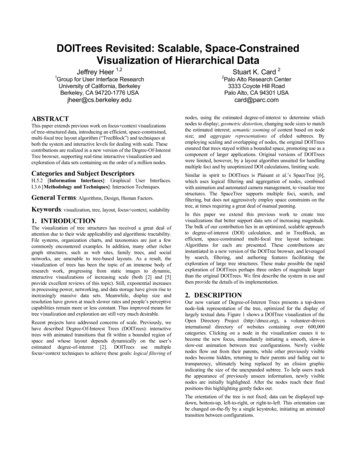
Transcription
DOITrees Revisited: Scalable, Space-ConstrainedVisualization of Hierarchical DataJeffrey Heer 1,21Group for User Interface ResearchUniversity of California, BerkeleyBerkeley, CA 94720-1776 USAjheer@cs.berkeley.eduABSTRACTThis paper extends previous work on focus context visualizationsof tree-structured data, introducing an efficient, space-constrained,multi-focal tree layout algorithm (“TreeBlock”) and techniques atboth the system and interactive levels for dealing with scale. Thesecontributions are realized in a new version of the Degree-Of-InterestTree browser, supporting real-time interactive visualization andexploration of data sets containing on the order of a million nodes.Categories and Subject DescriptorsH.5.2 [Information Interfaces]: Graphical User Interfaces.I.3.6 [Methodology and Techniques]: Interaction Techniques.General Terms: Algorithms, Design, Human Factors.Keywords: visualization, tree, layout, focus context, scalability1. INTRODUCTIONThe visualization of tree structures has received a great deal ofattention due to their wide applicability and algorithmic tractability.File systems, organization charts, and taxonomies are just a fewcommonly encountered examples. In addition, many other richergraph structures, such as web sites, family trees, and socialnetworks, are amenable to tree-based layouts. As a result, thevisualization of trees has been the topic of an immense body ofresearch work, progressing from static images to dynamic,interactive visualizations of increasing scale (both [2] and [5]provide excellent reviews of this topic). Still, exponential increasesin processing power, networking, and data storage have given rise toincreasingly massive data sets. Meanwhile, display size andresolution have grown at much slower rates and people’s perceptivecapabilities remain more or less constant. Thus improved means fortree visualization and exploration are still very much desirable.Recent projects have addressed concerns of scale. Previously, wehave described Degree-Of-Interest Trees (DOITrees): interactivetrees with animated transitions that fit within a bounded region ofspace and whose layout depends dynamically on the user’sestimated degree-of-interest [2]. DOITrees use multiplefocus context techniques to achieve these goals: logical filtering of2Stuart K. Card 2Palo Alto Research Center3333 Coyote Hill RoadPalo Alto, CA 94301 USAcard@parc.comnodes, using the estimated degree-of-interest to determine whichnodes to display; geometric distortion, changing node sizes to matchthe estimated interest; semantic zooming of content based on nodesize; and aggregate representations of elided subtrees. Byemploying scaling and overlapping of nodes, the original DOITreesensured that trees stayed within a bounded space, promoting use as acomponent of larger applications. Original versions of DOITreeswere limited, however, by a layout algorithm unsuited for handlingmultiple foci and by unoptimized DOI calculations, limiting scale.Similar in spirit to DOITrees is Plaisant et al.’s SpaceTree [6],which uses logical filtering and aggregation of nodes, combinedwith animation and automated camera management, to visualize treestructures. The SpaceTree supports multiple foci, search, andfiltering, but does not aggressively employ space constraints on thetree, at times requiring a great deal of manual panning.In this paper we extend this previous work to create treevisualizations that better support data sets of increasing magnitude.The bulk of our contribution lies in an optimized, scalable approachto degree-of-interest (DOI) calculation, and in TreeBlock, anefficient, space-constrained multi-focal tree layout technique.Algorithms for each are presented. These contributions areinstantiated in a new version of the DOITree browser, and leveragedby search, filtering, and authoring features facilitating theexploration of large tree structures. These make possible the rapidexploration of DOITrees perhaps three orders of magnitude largerthan the original DOITrees. We first describe the system in use andthen provide the details of its implementation.2. DESCRIPTIONOur new variant of Degree-of-Interest Trees presents a top-downnode-link representation of the tree, optimized for the display oflargely textual data. Figure 1 shows a DOITree visualization of theOpen Directory Project (http://dmoz.org), a volunteer-driveninternational directory of websites containing over 600,000categories. Clicking on a node in the visualization causes it tobecome the new focus, immediately initiating a smooth, slow-inslow-out animation between tree configurations. Newly visiblenodes flow out from their parents, while other previously visiblenodes become hidden, returning to their parents and fading out totransparency, ultimately being replaced by an elision graphicindicating the size of the unexpanded subtree. To help users trackthe appearance of previously unseen information, newly visiblenodes are initially highlighted. After the nodes reach their finalpositions this highlighting gently fades out.The orientation of the tree is not fixed; data can be displayed topdown, bottom-up, left-to-right, or right-to-left. This orientation canbe changed on-the-fly by a single keystroke, initiating an animatedtransition between configurations.
Figure 1 DOITree visualization of the Open Directory Project (http://dmoz.org). The tree contains over 600,000 nodes, laid out ina right-to-left orientation. Multiple foci have been selected and the various expanded branches are allocated as much space aspossible given the display constraints.Figure 2 Search and Filtering in DOITrees. As the Filter slider on the bottom right of the display is moved further to the right, the DOIdistribution becomes increasingly constrained, creating more compact views by reducing context. The tree moves from a full fisheye tojust search results and their ancestors, to finally just search results and their least common ancestors.Figure 3 Block-level representation of a visualized tree. Siblings and lower-interest subtrees are grouped together in rigidblocks to simplify layout. Additionally, the tree is segregated into varying depth levels (indicated by the markers above the tree)to facilitate dynamic computation of space requirements.
To support comparison across tree branches, users can selectadditional focus nodes. This is currently achieved by right clicking anode, thereby assigning it maximal user interest. The underlyingTreeBlock layout algorithm responds by expanding multiple treebranches as necessary, maximizing the allocated space for eachexpanded branch, subject to the space constraints of the display.Deeper tree paths (e.g., those rooted at “Arabic” and “Hebrew” inFigure 1) expand to use up available space underneath other, shortertree paths (e.g., the one rooted at “Farsi”). In our experience the useof curved edges helps offset the disorientation that can arisefollowing tree paths through the limited display space.2.1 Space ConstraintsProblems naturally arise, however, when the display space is notsufficient for displaying the current view of the tree. Theseproblems can occur along both the breadth and depth dimensions.When the tree breadth exceeds the display bounds a number ofsolutions may be applied. One approach is to use scrolling orpanning. Another technique is to scale the tree, as done by bothzooming interfaces and earlier versions of DOITrees [2]. Nodes canalso be overlapped, as done in [2]. A common organization chartconvention, incorporated by both DOITrees and SpaceTrees, is tolayout nodes along multiple rows. Three-dimensional visualizationscan also apply natural perspective, using rotation to selectivelypresent sibling nodes as done in Cone Trees [7].An additional mechanism used by our visualization is to aggregatenodes of lower interest. When expanded tree branches contain toomany nodes to fit on the screen at once, the nodes of lowestestimated interest are automatically culled until the tree breadth fitswithin the display, replacing these nodes with an aggregaterepresentation (as in the “World” category in Figure 1). Clickingthis aggregate will redistribute the estimated interest between thenodes in the branch. This expands the aggregate, revealing hiddennodes while previously visible nodes are newly aggregated.Space constraints also pose a problem along the depth dimension.As increasingly deeper levels of the tree are visualized, the tree maybecome too large for the display. Again, scrolling/panning andscaling techniques can be applied. In addition to tree scaling,DOITrees now support automatic panning of the tree view, centeredon the most recent user-selected focus node. To provide treecontext, the visualization presents a “bread-crumb” trail of ancestornodes along the periphery of the visualization (see Figure 2).Clicking on such a node causes the view to translate and ancestorsto “fall” from the bread-crumb trail into their proper positions.2.2 Exploring Large TreesIn addition to the problem of space constraints, the massive scale ofimportant data sets (e.g., web indices and biological taxonomies)presents additional challenges to the user. As we describe in theMethod section, we utilize efficient Degree-of-Interest estimationand tree layout techniques to ensure real-time interaction with treeson the order of a million nodes. However, this still leaves users withthe challenge of exploring incredibly large information structures.To help facilitate user interaction with such structures, DOITreessupport search and advanced filtering options, similar to those foundin the SpaceTree [6]. Users can additionally create their own treesof bookmarked nodes, building spatial indices of large data sets.Typing a query into the search box causes matching nodes to lightup in the visualization. Subtree aggregates light up to indicatebranches containing search hits. A linear list of search results isavailable to the user; double clicking an entry in the results list takesthe user to that section of the tree.Additionally, users can have search results treated as foci of thedisplay, causing all branches containing search hits to be expanded(see Figure 2). For searches with many matches this may result in anoverwhelming tree. Search filtering can be used to prune thedisplay, controlled by both the mouse scroll wheel and an on-screenslider. At the lowest pruning level a full fisheye distribution is used,at the medium level only focal nodes and their ancestors arevisualized, while at the highest level only focal nodes and their leastcommon ancestors are displayed. This last setting can be especiallyuseful for collapsing visualizations in which the search results occurat varying depths of the tree. Using the mouse scroll wheel switchesbetween filtering levels while staying within the context ofbrowsing, enabling users to dive in and out of search results on-thefly.Finally, we suspect that many users may want to bookmark areas ofthe tree, either for comparison purposes or to facilitate revisiting. Tosupport this across sessions, we allow users to create index trees,user-organized subsets of the larger data set. Users can click on anode in the larger tree and then drag it onto the index tree window,placing the nodes in the desired location in the tree. The index treeis a full DOITree visualization in its own right, with the additionalfeature that double clicking a node in the index tree causes thecorresponding node in the original data set to become a focus node.This allows users to build their own task specific indices into largerdata sets, and save them for later use.3. METHODIn this section we describe the techniques employed to implementthe visualization just described. We present both a generallyapplicable caching approach for efficiently computing Degree-ofInterest estimates of relevant tree nodes, and TreeBlock, a novelspace-constrained, multi-focal tree layout algorithm.3.1 Degree-Of-Interest CalculationAt the core of our approach is the use of lightweight modeling of theuser’s interest to inform the layout and presentation of the tree. Userinterest is modeled using a Degree-Of-Interest (DOI) function [2, 3],which assigns a single number representing the estimated relativeinterest of the user to each node in the structure. This provides asimple yet powerful abstraction for determining which nodes will bevisualized and guiding subsequent layout and visual presentation.For general browsing, we currently employ a multi-focal version ofFurnas’ FISHEYE view [3] to compute the Degree-Of-Interest. Thisfunction assigns a maximal DOI to focus nodes and their parents, upto the root of the tree. Interest values for the remaining nodes thendecrease linearly as a function of distance from the highest interestnodes. As nodes below a particular interest threshold will not bevisualized, we exploit the convexity of the FISHEYE distribution[3] to stop the interest calculation routine at these “disinterestthreshold” boundaries, thus bounding computation time to thenumber of visible nodes only. For non-convex DOI distributionsconsisting of convex subsets (e.g., the least common ancestors viewabove) calculation time is bounded by the number of visible nodesplus the number of nodes linking visible regions.We have implemented this technique using a caching scheme thatmaintains visual representations only for those tree elements above
the disinterest threshold and thus considered sufficiently interestingfor display. Tree nodes are added to the cache, if not alreadypresent, when their DOI is set. Tree links between cache entries aremaintained separately from the original tree, allowing DOI to varydiscontinuously across the tree. For each cache entry, a counterkeeps track of the number of interaction cycles since the entry waslast visited by a DOI function. When this count surpasses athreshold value (typically 1), the entry is removed from the cache.This process preserves the state of nodes that remain visible acrosstransitions while freeing space as nodes become elided. Thus quitelarge trees can be visualized by displaying in full detail only alimited subset of the total structure at a given time.00-1-2-3-30-2-3-10-30-1-1-2Fisheye DOI Distribution0-2-2-20-2-2-2-20-2Groups of siblings and subtrees containing only lower-interest nodesare grouped into blocks, which allow the aggregated nodes to besubsequently positioned as a single unit. This block structure isdepicted in Figure 3. The blocks are indexed by their depth level inthe tree, while the depths of subtrees are indexed by their sub-level,as depicted by the markers at the top of the figure. This segregationallows each depth level of the tree to be separately considered withrespect to space constraints and positioning, in turn enabling aflexible handling of multiple foci.3.2.2 Space Constraints-1-1requirements are computed. Node sizes, which may be variable inboth breadth and depth, are computed in constant time by queryingrendering modules. Global data structures monitoring the depthrequirements for each level of the tree are maintained, allowingdepth requirements for particular levels of the tree to be dynamicallycomputed across different tree branches.-2Disinterest Thresholding: minDOI -1Figure 4 Fisheyes with and without optimized DOI calculation.Nodes with a dotted outline are not visited by the algorithm.Using this formulation of DOI simplifies other aspects of ourimplementation. For instance, to visualize the distribution of searchresults in a bounded space, we can simply change the DOI functionso that branches of the tree without any search hits are assignedinterest levels below the visible threshold. Generalizing thisapproach, one can use DOI functions to visualize results for a widerange of dynamic queries. The modularity of the DOI functionallows this to be done without modifying downstream componentssuch as the layout algorithm.3.2 Tree LayoutOnce the DOI calculation is complete, we can proceed with theactual layout of the tree. In this section we describe TreeBlock, anew layout algorithm that achieves space-constrained, multi-focallayout in time nearly-linear to the number of visible nodes. Thealgorithm first makes a preliminary pass through the tree, computingthe space required by an unconstrained layout while alsosegmenting the tree into higher-level blocks. This information isthen used to constrain the layout of the tree so that it fits into theavailable space. Trees of excessive depth are handled by translatingthe view of the tree, while providing a “bread-crumb” trail of anyparent nodes that are no longer visible. Trees of excessive breadthare handled by aggregating nodes of lower interest. A final passthrough the tree then assigns nodes to their on-screen locations.3.2.1 Tree Extents and SegmentationThe first phase of our layout algorithm computes the space taken bythe tree in the absence of any display constraints, simultaneouslysegmenting the tree into a block structure to simplify subsequentlayout calculation. The output of this phase is the breadth and depth,in pixels, of the unconstrained tree layout, and an aggregated blockrepresentation of the tree (see Figure 3).The to-be-visualized subset of the tree is traversed in a depth-firstfashion, and for each group of siblings the breadth and depthIn the second phase of the layout algorithm, the computed treebreadth and depth values are compared against the bounds of theavailable display space. If the breadth and depth values from theunconstrained layout do not exceed the available space, nothingextra need be done. However, if the either of these values exceedsthe bounds of the display, the tree size must be reduced.3.2.2.1 Handling Excessive BreadthIn the case of excessive breadth, aggregation can be applied inaddition to or in lieu of scaling. For a given depth level withexcessive breadth, aggregation removes the nodes of lowest interestuntil the depth level fits within the display bounds. Removed nodesare then represented in aggregate (e.g., the siblings of “Arts” under“Humanities” in Figure 3). Clicking on one of these aggregatescauses the DOI values of the aggregated nodes to rise, which in turncauses the aggregate to expand, revealing a subset of elided nodes.Aggregates are computed by sorting all the items in the given depthlevel by their DOI values, then sequentially removing the lowestinterest nodes and updating size calculations until the blocks will fitwithin the display bounds. Since the lowest-interest nodes may bedispersed throughout the given depth level, this requires some bookkeeping of elided nodes, updating size calculations when adjacentnodes are marked for aggregation.3.2.2.2 Handling Excessive DepthIn the case of excessive depth, the tree is too tall for its allottedspace. One solution, applied in the contexts of both geometricscaling [2] and zooming [6], is to scale the tree to fit. Excessivescaling, however, eventually destroys the legibility of the tree. As aresult, in some cases (e.g., largely textual data) scaling can beundesirable. One recourse is to introduce scrolling or panning [6].The solution implemented in our current work is to automaticallytranslate the view, centering the visualization on the most recentuser-selected focus node. A bread-crumb trail of elided ancestors isused to maintain context and provide immediate access to higherlevels of the tree. The translation component is determined bycounting how many depth levels, starting from the root, must beremoved to allow the user-selected focus and its children to fit intoview. In addition, we add some extra logic to prevent the tree fromtranslating back and forth as the user browses a group of siblingswith descendants of shifting depth requirements. This prevents thejarring effect of the focus unduly bouncing around.
0 .1 4 03.2.3 Position AssignmentTo facilitate users’ visual search, we would like children blockscentered underneath their parent nodes. Due to screen bou
Visualization of Hierarchical Data Jeffrey Heer 1,2 1Group for User Interface Research University of California, Berkeley Berkeley, CA 94720-1776 USA jheer@cs.berkeley.edu Stuart K. Card 2 2Palo Alto Research Center 3333 Coyote Hill Road Palo Alto, CA 94301 USA card@parc.com ABSTRACT This pa
